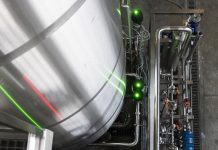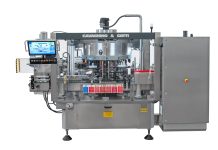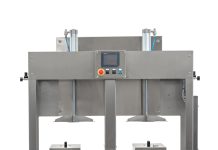
The WAK cap is a new closure, patented by Guala Closures, recently introduced on the market and seems to have good perspective for the future; it allows presenting the bottle with an aesthetic much more similar to the classical bottle closed with corks (Picture 3). The liner and the capsule are made of the same materials used for the ROTE caps but inside the structure of the WAK caps is very different since it contains the thread required for the closure, not visible from outside: the application is different since it requires a compression on the top of the bottle followed by a screwing movement around its neck. The performances of the screw caps seem to be very good on white wines or wines to be drunk young; therefore products that do not need any refi nement in the bottle since the gas exchanges with the exterior are very limited allowing the reduction of unwanted oxidation of the product and the use of SO2 during the bottling. The disadvantage can be the appearance of anomalies associable to the reduction fl avour generated from the long storage times of the wine. In fact, the ingress of oxygen is generally very low, as reported in various studies, even if it can vary according to the different permeability to oxygen of the liners [6, 7]. It is not completely clear, but it is being studied, if it is possible to use this type of caps for the bottling of red wines with longer shelf-life. The study reported below was aimed at testing the performances of the screw caps in comparison to natural corks and synthetic closures during the storage of wine in the bottle.
Experimental tests
Two types of Chardonnay wine, one form Burgundy and one from New Zealand, were submitted to the test. As T the fi rst sample, the wine had been bottled with three different closures: natural cork, synthetic cork, and screw cap (Wak type, Tin Foil liner); the bottles were held lying at the controlled temperature of 16±2°C and the maturing of wine was monitored for 9 months after the bottling. The second wine submitted to the test was bottled with the Wak cap only (with Tin foil liner) under low depression and nitrogen atmosphere with a head space of 28-30 mm; the bottles used for the study were stored in vertically at controlled temperature (16±2°C) for a period of 12 months. The evolution of the products analysed was monitored controlling their chemical parameters every third month and every 3 or 6 months they underwent to a descriptive sensory analysis. All analysis were made three times, the chemical analysis performed concerned the parameters of alcohol, pH, total acidity, volatile acidity, total and free sulphur dioxide, acetaldehyde, colour while the sensory analysis evaluated colour, aroma, and taste, and searched for possible anomalies. The chemical analysis were made according to official method of analysis of the EC [8], while a form with a point scale with values from 0 and 7 was prepared for the sensory analysis. All data collected were elaborated with SPSS software.
Results
Chablis Bourgogne
As for the Chablis, the multivariate analysis shows that time is the most important factor separating the data concerning some chemical parameters of the wine at the moment of the bottling from those obtained after 9 months’ storage. In particular some significant decreases of total and free SO2 and simultaneously an increase in the optical density to 410 nm and of acetaldehyde were noticed. Considering the whole storage period important differences were found as to maintenance of the levels of total and free sulphur anhydride, always higher in screw-capped wines then in those with the other two types of closures (tables 1 and 2) [9]. After one year, the descriptive qualitative sensory analysis showed that the screw-capped sample resulted to be the most appreciated. At the visual examination that wine showed a pale straw yellow colour and olfactory it had a good intensity with particularly fruity notes. The aspects of taste showed good acidity and structure giving it good balance, the bitterly aftertaste can be ascribed to the
sulphur dioxide. The cylindrical closures are easily recognisable for their olfactory sensory and taste characteristics always less fresh and intense. The wines corked with synthetic closures were those showing less freshness, partially covered by notes of oxidation.




